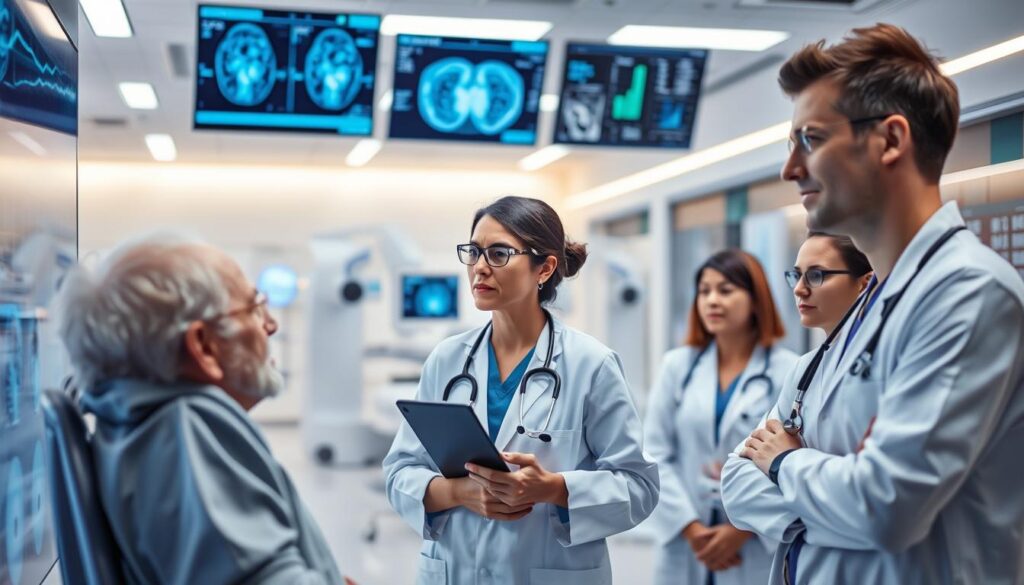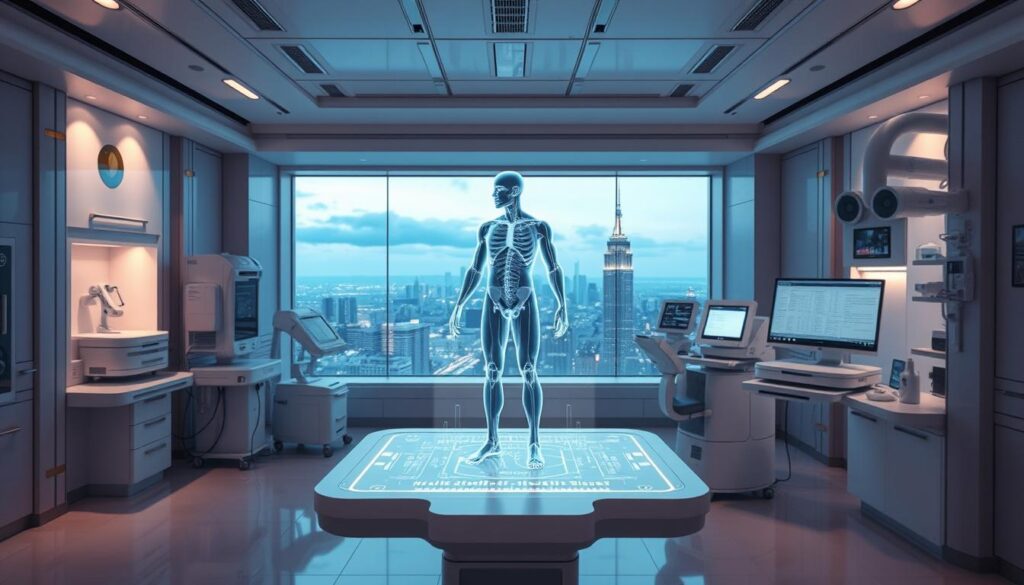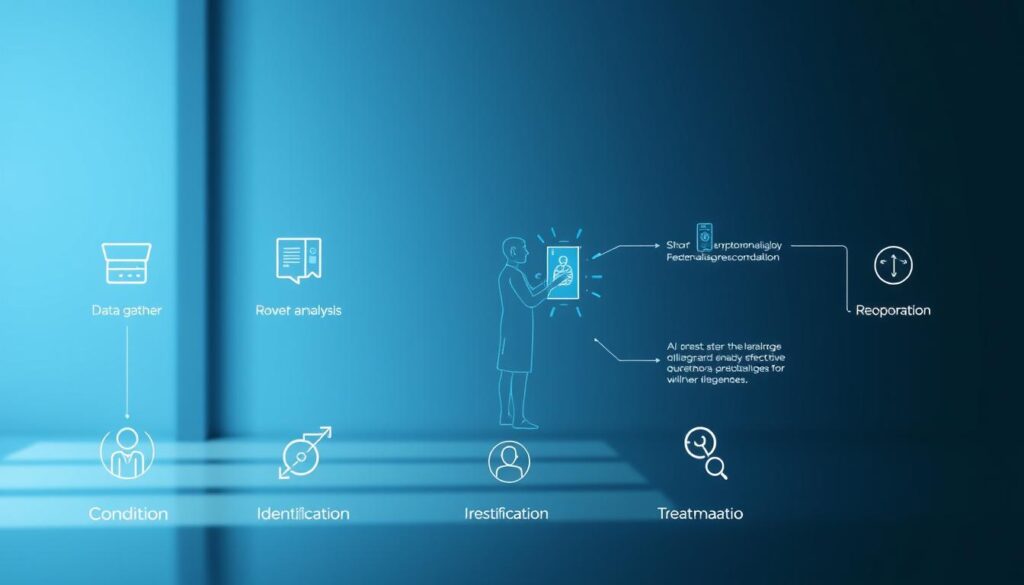Imagine a future where understanding your health starts with a conversation. AI diagnostics tools like ChatGPT are changing how you check symptoms and manage your well-being. These ai tools use advanced algorithms to analyze your symptoms, offering quick insights that can guide you toward next steps. From common colds to complex conditions, chatgpt and similar platforms provide accessible symptom checking options right from your device.

Traditional doctor visits remain vital, but ai diagnostics now bridge gaps in speed and accessibility. This guide explains how tools like ChatGPT work, their benefits, and how to use them responsibly. You’ll learn practical steps to enhance your health awareness without leaving home.
Key Takeaways
- AI tools like ChatGPT offer fast symptom checking for initial health insights.
- Ai diagnostics reduce wait times but should never replace professional medical advice.
- ChatGPT analyzes symptoms using data patterns to suggest possible health concerns.
- These tools empower you to prepare questions and track symptoms before seeing a doctor.
- Understanding ai tools helps you make informed decisions about your health journey.
The Rise of AI in Healthcare Diagnostics

Healthcare is changing quietly. Artificial intelligence is now a key part of healthcare technology. It’s making a big difference in how we check for symptoms.
How Artificial Intelligence is Transforming Healthcare
Imagine a system that checks millions of medical records in seconds. Artificial intelligence does this every day. Tools like IBM Watson and Google Health find patterns humans miss.
This makes decisions faster, cuts down on mistakes, and brings new insights to clinics.
The Evolution from Traditional Diagnosis to AI-Assisted Assessment
| Traditional Methods | AI-Assisted Methods |
|---|---|
| Physical exams, lab tests | Data analysis, predictive modeling |
| Time-consuming for complex cases | Instant symptom prioritization |
Why Symptom Checking is the Perfect Application for AI
Symptom checking is all about finding patterns. That’s what AI is great at. Apps like Ada and Babylon Health use your symptoms to find matches in thousands of cases.
This gives you personalized advice right away. A 2023 study in JAMA showed these tools can spot problems 30% faster.
“AI isn’t replacing doctors—it’s giving them better tools to focus on what humans do best: care.” — Dr. Lisa Su, Stanford Healthcare Innovations Lab
Whether you use an app or a clinic’s system, this tech helps you get answers quicker. It connects you with care faster and helps you make smart health choices.
Understanding How AI Diagnostics Work
AI diagnostics use machine learning algorithms to learn from vast medical data. They analyze symptoms, medical histories, and test results to spot patterns. It’s like feeding a computer millions of cases—like headaches linked to migraines or fevers tied to infections.
Over time, it learns to predict possible health issues based on your input.

Diagnostic software like these tools work by turning your descriptions into data. For example, when you mention “chest pain,” the system checks it against known conditions. It uses natural language processing to understand everyday words, not just medical jargon.
This means you don’t need a degree to use it!
- Rule-based systems: Follow set medical guidelines to suggest possibilities.
- Deep learning: Uses neural networks to find hidden links between symptoms and diseases.
These tools also consider your age, gender, and risk factors. If you’re a smoker with a family history of diabetes, the diagnostic software highlights related risks. But remember—AI isn’t a diagnosis. Think of it as a first step, not a final answer. Always consult a doctor for confirmation.
By knowing how these tools work, you’ll better interpret their suggestions. They’re powerful aids, but human expertise still guides the final decision.
AI Diagnostics: ChatGPT and AI Tools for Symptom Checking
ChatGPT is a top choice for understanding symptoms with its large language model. It compares your input to huge health data sets. Unlike some chatbots, it focuses on how you talk rather than health databases. It’s a good first step to explore health concerns.
How ChatGPT Interprets Your Symptoms
ChatGPT uses natural language processing to ask follow-up questions about symptoms. It looks for patterns in your answers. It can’t give medical advice, but it suggests when you might need urgent care.
Popular AI Diagnostic Platforms Beyond ChatGPT
- Ada Health: Offers a structured questionnaire for precise symptom tracking.
- Babylon Health: Integrates with UK health systems for personalized recommendations.
- K Health: Uses doctor-vetted data for symptom analysis in the US.
- Buoy Health: Provides triage guidance using AI algorithms.
Comparing AI Tools: Features and Capabilities
| Feature | ChatGPT | Ada Health | Babylon Health |
|---|---|---|---|
| User Interface | Conversational chat | Step-by-step quiz | Interactive health check |
| Medical Knowledge Base | General health info | Doctor-curated data | NHS guidelines |
| Uncertainty Handling | Notes limitations clearly | Shows probability scores | Flags emergency cases |
Each tool has its own strengths. ChatGPT is great for quick insights. Ada Health is good for detailed analysis. Babylon Health is best for advice linked to local healthcare networks. Pick the one that fits your needs.
Benefits of Using AI for Your Health Concerns
Imagine having a health advisor ready to help anytime, anywhere. Healthcare technology like ai diagnostics makes this possible. These tools let you manage your health in ways traditional care can’t.
Accessibility and Convenience Factors
Living in a rural area or being busy? Symptom checking platforms like Babylon Health or Ada are here for you. They offer quick advice any time, day or night. No more waiting for hours to get help.
Cost Effectiveness Compared to Traditional Healthcare
Using ai diagnostics can save you money. A 2023 study showed it can cut ER costs by up to 35%. Here’s how:
- Free or low-cost first consultations
- Less need for routine visits
- More targeted specialist referrals
Speed of Assessment and Preliminary Insights
Traditional visits can take weeks to schedule. But healthcare technology gives you instant results. Here’s the comparison:
| Scenario | Traditional Care | AI Tools |
|---|---|---|
| First assessment time | 1-2 weeks | Minutes |
| Symptom tracking | Manual logs | Automated charts |
| Question preparation | Unorganized notes | AI-generated lists |
“AI diagnostics help patients present clearer histories, leading to better in-person care outcomes.” – Mayo Clinic Health Technology Report (2023)
Limitations and Ethical Considerations
ai tools like artificial intelligence systems are handy but have their limits. They use machine learning algorithms based on past data. This means they can’t handle unique symptoms or medical histories.
Don’t rely solely on their advice. ai tools can’t replace a doctor’s hands-on check-up.
- Accuracy gaps: AI may misinterpret rare conditions or overlook critical details.
- Data privacy risks: Your health info stored in these systems could be vulnerable to breaches.
- Bias in algorithms: Training data gaps might lead to less accurate results for underrepresented groups.
“AI is a guide, not a decision-maker,” says industry research from the National Institutes of Health. “Human oversight remains essential.”
Rules are changing to tackle these issues. Ask your healthcare providers about data security and bias prevention in their machine learning algorithms. Always check your results with a doctor. While artificial intelligence can help with initial checks, it’s up to you to mix tech insights with real medical advice.
How to Effectively Use AI Diagnostic Tools in Your Healthcare Journey
Using AI tools like ChatGPT andvirtual symptom checkers requires understanding their capabilities and limitations. Here’s how to maximize their benefits while ensuring safety.
- Chronological details: Note when symptoms started and how they’ve changed.
- Quantify when possible: “Headache lasted 3 days” vs. “I have a headache.”
- Avoid assumptions: Say “sharp chest pain,” not “I think I have a heart issue.”
“Accuracy hinges on honest, detailed input,” says Dr. Lena Torres, a digital health expert. “AI thrives on clear data.”
2. Know When to Rely on AI—and When to Seek Help
For minor issues like rashes or allergy symptoms, amedical chatbot is helpful. Ai diagnostics tools can spot potential problems. Butalways consult a doctor for:
- Sudden vision changes or severe chest pain.
- Unexplained weight loss or high fever.
- Symptoms worsening after AI advice.
3. Bridge AI Insights with Professional Care
When discussing ChatGPT results with your doctor:
- Print or save the AI’s analysis to review together.
- Ask questions like, “How does this align with your diagnosis?”
- Use AI findings as a starting point, not a substitute for exams.
Combining virtual symptom checkers with human expertise leads to better care. Your role? Be curious, honest, and keep the dialogue open between tools and your healthcare team.
Conclusion: The Future of AI in Personal Health Management
AI diagnostics like ChatGPT are changing healthcare. They will soon offer quicker, more tailored advice. Imagine apps that check your symptoms and data from devices like Fitbit or Apple Watch, giving a clearer health picture.
Healthcare tech is getting better, linking ai tools with your medical records. This makes it easier for doctors to see your ai findings. It could reduce unnecessary visits and speed up treatment. Companies like Google Health and Babylon Health are already testing these systems.
Regulations are also changing. The FDA has approved new ai tools for symptom checking, making them safe and accurate. This means you can trust these tools to track your health at home. But remember, ai tools are guides, not a full replacement for doctor’s advice.
In the future, ai diagnostics will be a key part of keeping you healthy. By using these tools wisely, you can catch problems early and take care of your health. The aim is to have ai tools and healthcare providers working together to keep you well for longer.
FAQ
What are AI diagnostics and how do they work?
AI diagnostics use artificial intelligence to check symptoms and guess health issues. They look at big data to find patterns. This makes checking symptoms easier and more accessible.
Can I rely solely on AI tools for my healthcare needs?
AI tools can give useful insights but shouldn’t be the only thing you use. Always talk to a doctor for a real diagnosis and treatment plan.
How does ChatGPT differ from other AI diagnostic platforms?
ChatGPT uses natural language to understand your symptoms in simple terms. This makes it different from other AI systems that use medical databases. It helps make complex medical terms easier to understand.
What are the benefits of using AI diagnostic tools?
AI tools are always available for health advice, can save money, and give quick symptom feedback. They help you track your health and prepare for doctor visits. They empower you to manage your health better.
Are there limitations to AI diagnostics?
Yes, AI tools aren’t as accurate as doctors. They might miss unique health details and can have biases. Always get a professional check-up when needed.
How can I use AI diagnostic tools effectively?
To get the most from AI tools, describe your symptoms clearly. Know when to use them and when to see a doctor. Using AI insights with doctor advice can help you better understand and treat health issues.
Read: Hybrid Care Models: Post-pandemic expansion and insurance coverage debates
Pingback: Hybrid Care Models: Post-pandemic expansion and insurance coverage debates - Mahnoor Health and Wealth